
Jack Davis Was Ahead Of His Time
Jack Davis of Southern California easily won a record three NCAA high hurdles titles.
It was in a second event that he found close competition.
As a sophomore in 1951, Davis began a three-year stretch of scoring the most points on a USC national championship team. He won the 120-yard hurdles in 13.7, two tenths better than the meet record, then added a third in the 220-yard low hurdles. Though his 120H victory by three tenths of a second stood, the meet record didn’t as the starter claimed Davis used an illegal advantage to propel himself out of the blocks.
“I didn’t get a rolling start,” Davis was quoted as saying by Cordner Nelson in Track & Field News. “I was rocking back at the gun.”
The closest finish Davis had in an NCAA high hurdles race came in 1952 when he equaled the 110H meet record of 14.0 to win by two tenths over Stanford’s Bob Mathias. For the versatile Mathias – who won the 1948 Olympic decathlon gold while in high school – it matched his best finish in the NCAA meet as he was also second in the 1951 discus (Mathias repeated as Olympic gold medalist in 1952).
With 1952 being an Olympic year, the NCAA contested events at metric distances – and that included the 400-meter intermediate hurdles instead of the 220-yard lows – so Davis added a different second event, the flat 200-meters. Davis recorded the fastest heat time at 21.4 and followed with a 21.5 semi, both times finishing ahead of defending champ George Rhoden of Morgan State. In the final, though, Drake’s Jim Ford overtook Davis to win by a tenth in a meet-record 21.0 (Rhoden did not compete in the final).
“I didn’t know I could run a 200,” said Davis, who reportedly entered the event on a bet with his coach. “I tried to beat the gun in my heat.”
By 1953, the native of Glendale, California, was a clear favorite for a record third NCAA high hurdles title – especially after a silver medal to Harrison Dillard in the Olympics the previous summer, when both were timed in 13.7.
Davis not only won his third high hurdles title, but also completed his first NCAA double, winning both events over Joel McNulty of Illinois – the 120H by three tenths in 14.0 and the 220H by two tenths in 23.3. The 14.0 was just a tenth off the meet record, while the 23.3 had then been bettered in meet history on a curve by Dillard at 23.0 and Jesse Owens and Fred Wolcott at 23.1.
It wasn’t until 2019 that Davis’ three victories in the men’s high hurdles at the NCAA Division level were matched: Eventual The Bowerman winner Grant Holloway of Florida completed his trio of 110H crowns with his collegiate record of 12.98.
After college, Davis set three world records in 1956 and repeated a silver-medal finish in the Olympics, again with the same time as the winner (North Carolina Central’s Lee Calhoun, 13.5).
The NCAA and collegiate track & field will mark a momentous milestone in the spring of 2021 -- the 100th anniversary of the NCAA Championships and with that, the NCAA Track & Field Championships. In June 1921, the University of Chicago hosted the first track & field championships in NCAA history.
This point can’t be emphasized enough: Not only was the event the first for NCAA track & field, but the first championships for any sport under the sponsorship of the NCAA.
To celebrate, over each of the next 365 days, the U.S. Track & Field and Cross Country Coaches Association (USTFCCCA) will celebrate moments, student-athletes, and coaches that have made a century’s worth of championships special. From humble beginnings to important historical milestones to the modern-day, collegiate track & field has evolved with the American society.
The 2021 edition of the NCAA Division I Outdoor Track & Field Championships begin with preliminary round action on May 27-29 in Jacksonville, Fla., and College Station, Texas. The championships final site and culmination of the celebration is slated for June 9-12, 2021 at the newly rebuilt Hayward Field in Eugene, Ore.
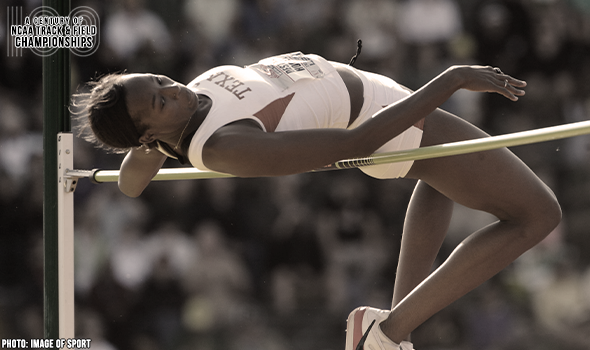
Texas’ Hooker High Jumped To NCAA Glory
Destinee Hooker won three career high jump titles at the NCAA DI Outdoor T&F Championships, including a massive victory in 2009 by more than two inches.
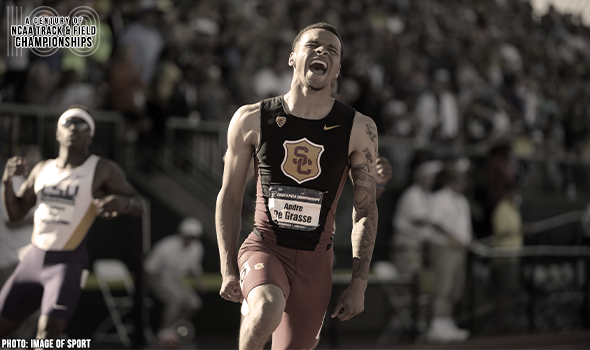
De Grasse Sprinted To Otherworldly Double
Andre De Grasse completed the 100-200 double at the 2015 NCAA DI Outdoor T&F Championships with scorching times: 9.75 (+2.7) in the 100; 19.58 (+2.4) in the 200.
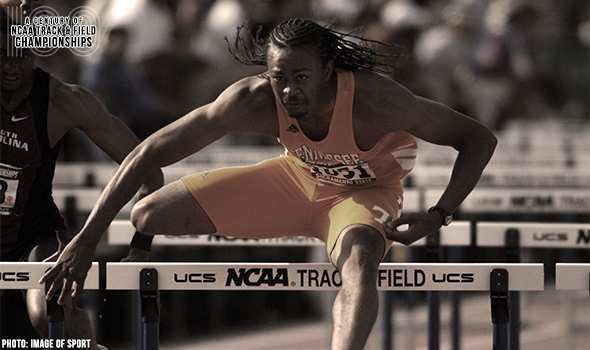
Merritt Broke Long-Standing 110H MR In 2006
Aries Merritt broke a 28-year-old meet record in the 110H when he won the crown at the 2006 NCAA DI Outdoor T&F Championships in 13.21.
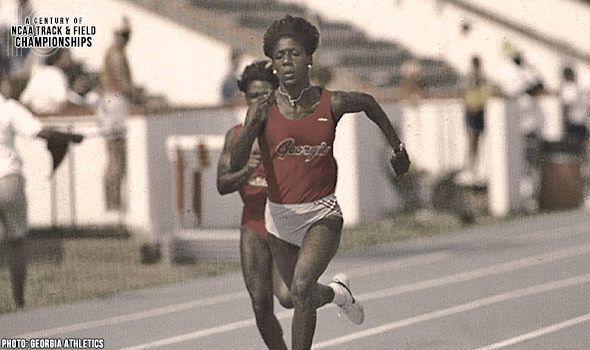
UGA’s Torrence Made NCAA History With Double
Gwen Torrence completed the 100-200 double at the 1987 NCAA DI Outdoor T&F Championships. Torrence was also the first woman to finish top-8 four times in the 100.
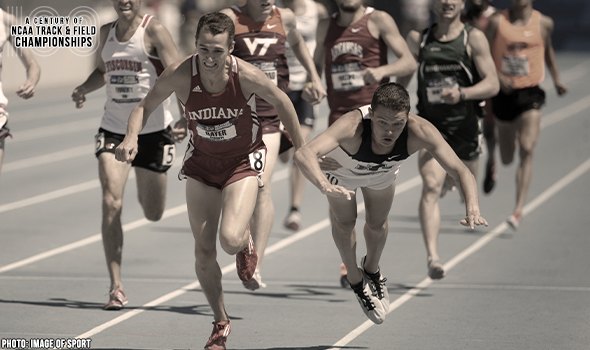
Bayer Gave It His All For NCAA 1500 Title
Andrew Bayer won the 1500 at the 2012 NCAA DI Outdoor Track & Field Championships in one of the closest finishes in meet history – 0.01 seconds.

Tipton Led 1-2-3 Oregon Finish In 1964 JT
Les Tipton led the first podium sweep of any event in the history of the NCAA Outdoor T&F Championships. Tipton and his Oregon teammates went 1-2-3 in the 1964 javelin.

K-State’s Jones Captured Heptathlon Crown In 2015
Akela Jones won the heptathlon at the 2015 NCAA DI Outdoor T&F Championships with 6371 points. That is the fourth-best score in both collegiate history & meet history.

Same Athletes, Same Result For LSU At NCAAs
The LSU foursome of Bennie Brazell, Pete Coley, Robert Parham, Kelly Willie swept the 4×100 & 4×400 crowns at the 2003 NCAA DI Outdoor T&F Championships.

Martin Won Distance Titles For Two Programs
Francis (Frank) Martin made history twice in the NCAA Outdoor Track & Field Championships.

FSU’s Williams Soared To Jumps Double In 2009
Kim Williams swept the horizontal jumps at the 2009 NCAA DI Outdoor T&F Championships. Williams was particularly dominant in the TJ, winning at 14.38m (47-2¼) & by nearly 2 feet.

